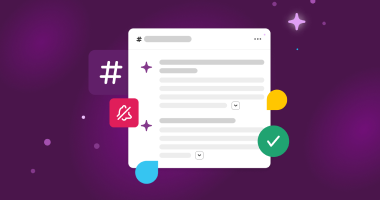Companies of all sizes are racing to understand how generative artificial intelligence can help their employees move faster and be more productive. But as the working world experiments with emerging AI strategies, many organizations have been slow to fully integrate the technology into their business operations.
Research from Slack’s Workforce Lab shows that 96% of executives feel the urgency to incorporate AI into business operations, and between September 2023 and March 2024, the number of leaders planning AI implementations in the next 18 months grew sevenfold. However, more than two-thirds of desk workers have still not tried AI for work, and 93% of them don’t completely trust it.
Slack and Salesforce wanted to dive deeper into this trend, so we commissioned a report by Harvard Business Review Analytic Services to explore how the world’s savviest business leaders are preparing for a future powered by gen AI. The report is filled with statistics; the potential impact of generative AI on work, according to business leaders; the cultural, organizational and technological challenges of driving AI adoption; and best practices that establish the leadership, talent, and culture required to boost productivity and enhance communication with AI.
When it comes to ways to win with gen AI, here are five takeaways from the report:
- Unify and manage your data in a secure and trusted environment. Start by piloting AI in a contained area of your business, like your Slack work platform, where employees can test it out according to your security policies (instead of in unapproved external apps).
- Create a clear, concise and attainable roadmap for deploying AI. Data-driven insights from consulting firms such as Deloitte and McKinsey can help you think through potential use cases that fit your business goals—but consider implementing only four to six at a time to keep things manageable.
- Develop governing structures to accommodate the evolving nature of gen AI. It’s important to set guiding principles and guardrails around how you use AI in your work. One of Harvard Business Review Analytic Services profiled companies created its own AI center of excellence by assembling a cross-functional team of leaders who regularly discuss AI trends, ethics, legal challenges and potential use cases.
- Strategize how you can automate common processes across your organization. Basic writing tasks, including emails, meeting notes and outlines, are a great place to introduce automation. Another way to be more efficient is to use trusted chatbots that can answer employee questions using your company knowledge base. Einstein Copilot, for example, is an AI assistant for customer relationship management available across Salesforce applications, delivering responses grounded in company data to answer questions, generate content and automate workflows.
- Champion change management at your organization. It’s crucial for smart leaders to understand how AI can transform their business operations while also remaining clear-eyed about the benefits AI can deliver in the near term. Change management and employee upskilling are two vital areas for investment where AI can help.

“AI tools must be deeply trusted, intuitively embedded in the flow of work and grounded in your business’s unique data. That’s the approach we’ve taken with Slack’s own AI capabilities.”
We’re only in the first inning of the AI revolution, and a full transformation won’t happen overnight. While AI will certainly help companies do their normal work faster and more efficiently, the real edge will come from the ability to innovate in ways that were impossible before. However, successfully forging a new path requires a well-conceived roadmap that leaders, employees and customers can trust.
As Slack CEO Denise Dresser shares in the report: “AI tools must be deeply trusted, intuitively embedded in the flow of work and grounded in your business’s unique data. That’s the approach we’ve taken with Slack’s own AI capabilities … that empower our customers to access the collective knowledge they’ve built up in Slack so they can work smarter, move faster, and spend their time on things that spark real innovation and growth.”
Dig into the data and read more about how leaders are deciding how to use generative AI to boost workforce productivity, automate work, simplify operations and more. Download Preparing for a future powered by generative AI today.




